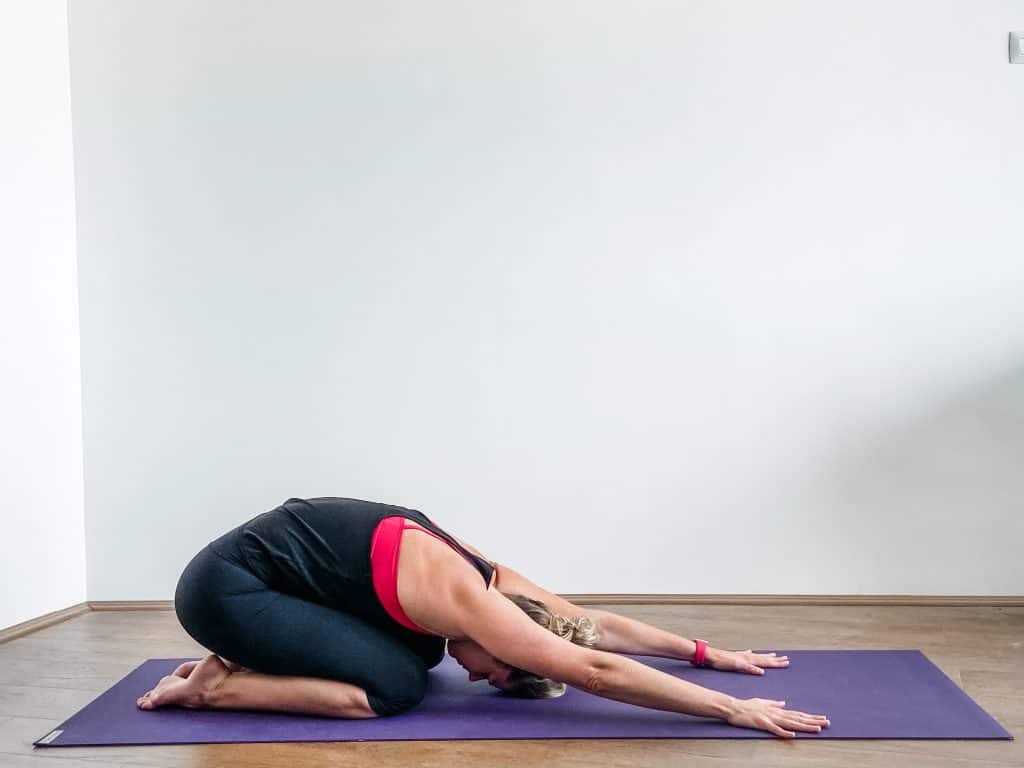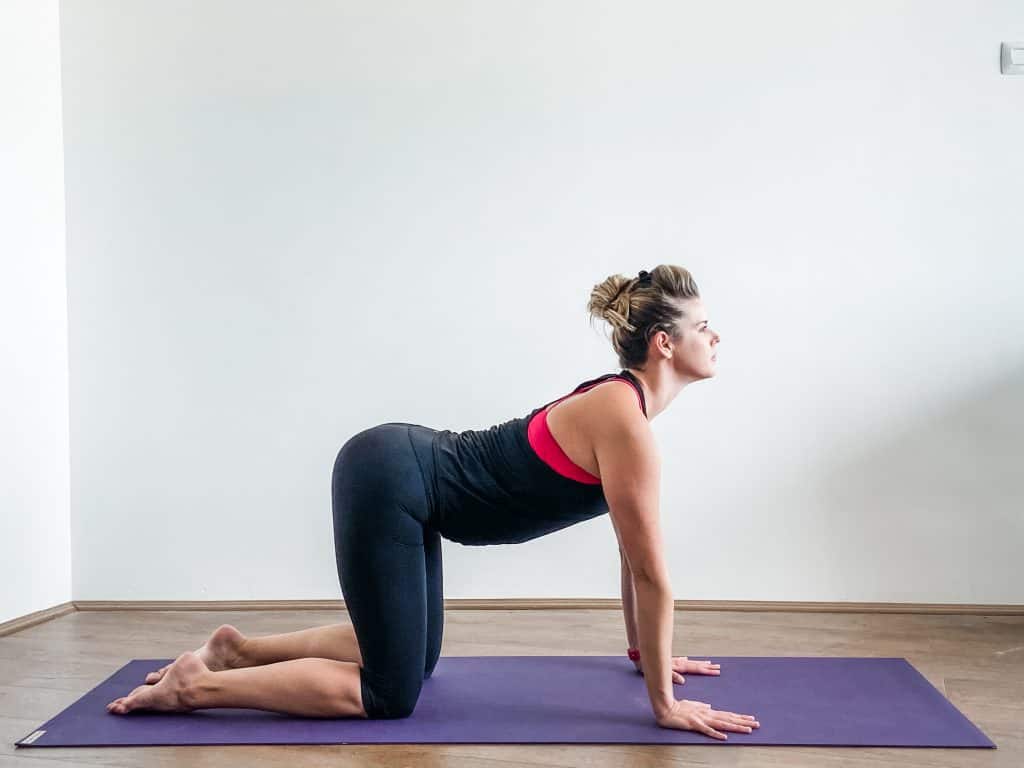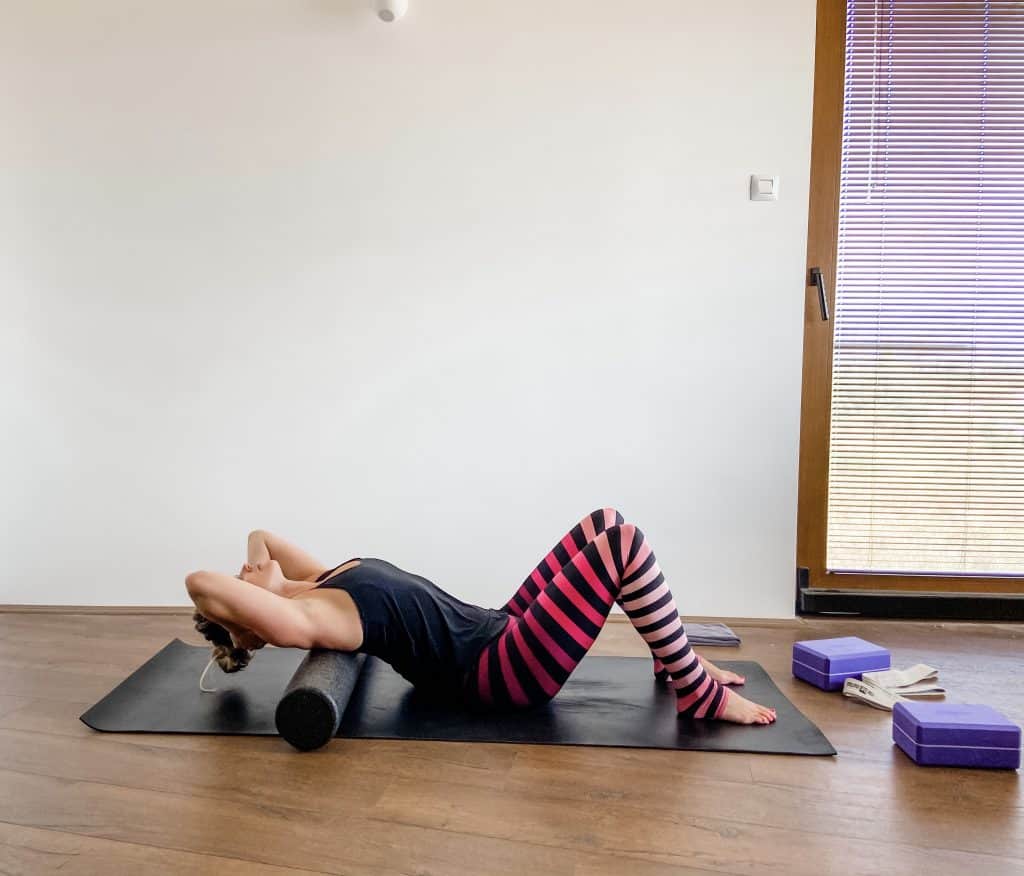This page contains affiliate links. I’m part of the lululemon collective and will receive a commission if you make a purchase through the links below. As an Amazon Associate, I earn from qualifying purchases. Read the full disclosure here.
Welcome to the spine flexibility library!
Maintaining good range of motion, flexibility, and mobility is an essential piece of healthy movement. On this page, you can find flexibility and mobility exercises for the spine.
For additional tips of stretching and injury prevention, check out What’s Really Going On When You Stretch?
To learn more about core muscles read The Skinny On Core Strength.
Disclaimer: This content is for educational purposes and is not medical advice. Read the full disclaimer.
Knee to chest
Knee to chest is a gentle flexion and can feel very unweighting to the spine. It can be done with one leg at a time or both legs at the same time.

How to perform:
- Lie on your back and slowly draw one or both knees into your chest
- Hold for 20-30 seconds – continue to take deep breaths.
- Repeat 2-3 times
Child’s pose
Child’s pose has many benefits, including a grounding pose for relaxation, resetting the nervous system, and a gentle, low back stretch.

How to perform:
- Kneel on the mat with legs hip-distance apart or knees wide
- Bring your forehead down to the mat and either stretch the arms out in front or bring them down by your sides.
- Blankets, blocks, or bolsters can be used for further relaxation or to support for limited flexibility in the hips or knees.
- Focus on deep breathing in this pose, stay as long as you need.
Sphinx pose (prone on elbows)
Sphinx is a very gentle backbend into extension. In physical therapy, this may be called prone on elbows or a prone prop.

How to perform:
- Lie on your stomach and bring yourself to prop on your forearms.
- Bring the elbows underneath the shoulders for the most extension into this position.
- Stay for 30 seconds to 1 minute, continuing to breathe deeply.
- Repeat 2-3 times.
Cobra (prone press-up)
Cobra is a more intense backbend than sphinx.

How to perform:
- Lie on your stomach and place your palms on the floor underneath your shoulders.
- Press into your hands to extend the spine as far as is comfortable for you, elbows do not have to be straight.
- Keep the shoulders away from your ears and pull the heart forward.
- Bend the elbows and lower yourself back down to the mat.
Cat-Cow
Cat cow is a great spine mobility exercise. It’s a gentle way to move the spine through flexion and extension and can also be a useful exercise to promote movement awareness and proprioception.
Cat

Cow

How to perform:
- Get into a tabletop position with shoulders stacked over wrists and hips over knees.
- For “cat,” exhale, round the spine, tuck the chin, and press the floor away.
- For “cow” inhale, drop the belly and lift the gaze.
- Slowly move through these two positions through as much range of motion that’s comfortable for you.
Lower Trunk rotation
Lumbar spine rotation in a supported position.

How to perform:
- Lie on your back with your knees bent and feet flat on the floor.
- Gently drop the knees to one side, as much rotation as is comfortable for you. The feet do not have to stay flat, just allow them to follow the legs’ motion.
- Return your legs to the center and gently drop them to the opposite side.
- Repeat 10-20 times or until you feel an improvement in mobility.
Thread the needle
Thread the needle focuses on thoracic (mid and upper back) rotation. Good thoracic spine mobility greatly helps the shoulder joint.

How to perform:
- Get into a tabletop position with shoulders stacked over wrists and hips over knees.
- Take one arm and thread it through the space between your opposite hand and knee.
- Come as far into the position as is comfortable, maybe dropping your ear down to the mat or a prop.
- Stay for 3-5 deep breaths.
- Return to tabletop and repeat on the other side.
- Perform 2-3x per side.
Deep breathing is especially important during this position as it helps to open up the ribs and facilitate functional thoracic mobility.
Thoracic open book
Another way to work into thoracic rotation is with the “open book” stretch.


How to perform:
- Lie on one side with your knees bent up to 90 degrees (Or however far is comfortable for you)
- Extend your arms at shoulder level and let them rest on the floor.
- Keeping your lower body still, raise the top arm and rotate to “open the book” as far as is comfortable. This can be intense for the shoulder, so you’re welcome to bend the arm at the elbow, or keep the palm against your chest to take out this piece.
- Take 2 deep breaths
- Slowly “close the book” and return to side-lying.
- Perform 10-20 on each side.
Thoracic extension on foam roller
A foam roller is a useful tool to self mobility the thoracic spine into extension.


How to perform
- Sit on the floor and place the foam roller perpendicular to your spine at the shoulder blades level.
- Cradle your head and neck with your hands. You’ll want to keep your neck in neutral while performing this stretch.
- Gently roll back, extending over the foam roller only as far as you feel comfortable.
- Slowly lift back up and repeat ten times.
- Keep your bottom on the floor the whole time, and keep your gaze on the top of your knees to protect your neck alignment.
Upper trapezius

How to perform:
- Allow your head to gently fall to the side, keeping the face forward.
- You can add gentle pressure by resting the same-side hand on the top of the head.
- Hold for 20-30 seconds.
- Repeat 2-3 times.
Levator Scapulae
Levator is a chronic offender of neck discomfort, running from the corner of the scapula, all the way to the top of the cervical spine.

How to perform:
- Look down toward your armpit.
- You can add gentle pressure by resting the same-side hand on the top of the head.
- Hold for 20-30 seconds.
- Repeat 2-3 times.
Suboccipital release
The suboccipitals are a group of muscles at the base of the skull. When you jut your head forward and then tilt your head up to read a screen, it can overwork these small muscles, leading to headaches.
This group is challenging to stretch because of anatomy, but if you’ve ever had a physical therapist or massage therapist cup the base of your skull with their fingers, you know how relieving this feels.
You can use two tennis balls or a foam roller.

How to perform
- Tape two tennis balls together, they will resemble a peanut-like shape (they can also be tied in a sock)
- Lie on your back and place the tennis balls at the base of the skull
- Allow gravity to use the weight of your head to release these muscles gently – don’t forcefully press your head into the tennis balls
- Gentle yes/no nods can add some mobility.
More Flexibility Resources
Ankle & Foot Flexibility Exercises
Equipment & Accessories
Shop foam rollers at Dick’s Sporting Goods and ProSource Fit
Best yoga mats:

